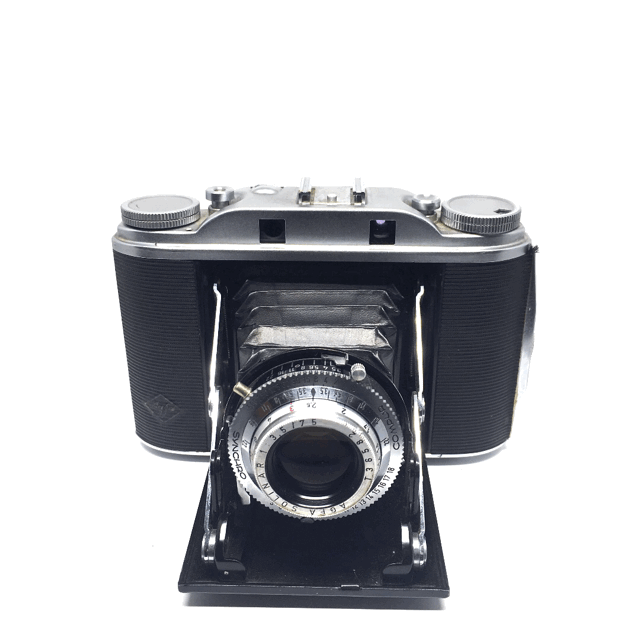
Agfa Isolette III
Die Agfa Isolette III, die um das Jahr 1955 in den Agfa Kamerawerken in München gebaut wurde, ist meine kleinste und leichteste Mittelformatkamera. So leicht, dass sie sich wunderbar auf Wanderungen, Fahrrad- oder Motorradtouren mitnehmen lässt. Manchmal packe ich sie auch als Mittelformat-Zusatzkamera in meine Fototasche, in der sich schon eine Film- oder Digitalsystemkamera mit mehreren Objektiven befindet.
Allerdings haben das geringe Gewicht und das schlanke Äußere der Isolette einen Preis: Um die Kamera so kompakt wie möglich zu machen, haben ihre Konstrukteure auf ein lichtstärkeres Objektiv, das einen größeren Linsendurchmesser erfordert hätte, ebenso verzichtet wie auf einen gekuppelten Entfernungsmesser oder eine Transportautomatik, wie sie meine andere 6x6 Klappkamera, eine Super Ikonta 530/16 von Zeiss-Ikon, besitzt. Verglichen mit der Isolette ist die Super Ikonta ein schweres Monster, was man besonders dann bemerkt, wenn man sie an einem Riemen vor der Brust trägt.
Dafür bietet sie aber auch mehr Komfort als die Isolette, mit der das Fotografieren noch viel Handarbeit bedeutet. So muss man die mit dem Entfernungsmesser festgestellte Meterzahl per Hand auf die Entfernungsskala des Objektivs übertragen, und wenn man den Rollfilm zum nächsten Bild transportieren will, muss man ihn so lange weiterdrehen, bis in dem kleinen roten Fenster in der Rückwand der Kamera die nächste Bildnummer auf dem Lichtschutzpapier erscheint.
Das Objektiv der Isolette allerdings kann mit dem Tessar der Super Ikonta durchaus mithalten - das vierlinsige 3.5/75 mm Solinar ist das beste Objektiv, das je in der Isolette verbaut wurde, während andere Kameras dieses Typs mit den Dreilinsern Agnar oder Apotar auskommen müssen.
Leider leidet meine Isolette unter den beiden Schwachstellen, die diesen Kameras (zu Recht) zugeschrieben werden. Die erste, das damals von Agfa verwendete Fett zum Schmieren beweglicher Teile des Entfernungsmessers und des Objektivs, lässt sich relativ einfach ausmerzen indem man die Kamera aufschraubt, das alte Fett, das sich im Lauf der Jahrzehnte in eine klebrige, grüne Masse verwandelt hat, mittels Feuerzeugbenzin entfernt und durch dünn aufgetragene technische Vaseline ersetzt.
Die zweite Schwachstelle der Isolette ist leider gravierender. Sie besteht darin, dass Agfa für die Balgen der Kameras anstatt dem üblichen dünnen, auf Stoff aufgeklebten Leder einen speziellen Kunststoff verwendet hat , der heute besonders an den Ecken so brüchig wird, dass winzige Löcher und immer größer werdende Risse entstehen. So verhält es sich auch bei meiner Isolette, wie man an den weißen Lichtstreifen auf einigen der Bilder in meiner Galerie sehen kann. Ich habe versucht, diesen Defekt durch das Aufkleben von schwarzem Isolierband zu minimieren, aber auf lange Sicht werde ich mir wohl von einem Bastler in England einen Ersatzbalgen bestellen, den man in verschiedenen Farben bekommen kann. Dunkelrot, denke ich, wäre nicht schlecht.
Agfa Isolette III
The Agfa Isolette, built around 1955 in the Agfa Cameraworks in Munich, is my smallest and lightest medium format camera. So light it is a pleasure to carry it with you on hikes, bicycle tours or - as i do quite often - pack it as a surplus 6x6 camera into your camera bag that houses a 35mm film camera or some digital equipment.
The light weight and slender build of the Isolette comes at a price, though. In order to achieve this amazing compactness the engineers had to sacrifice a faster lens (which would have a greater lens diameter) and features of convenience like a coupled rangefinder or an automated frame counter like my other 6x6 folder, a pre-war Zeiss Ikon Super Ikonta 530/16 with an uncoated 2.8/80mm Tessar. Compared with the Isolette the Super Ikonta is a big and heavy behemoth of a camera that really drags you down when you have it slung over your neck.
Taking pictures with the Isolette III is a rather basic and sometimes a bit cumbersome experience. You transport the film from frame to frame by watching a number on the backing paper appearing in a little red window and if you want to determine the proper distance to your motive you have to turn a little wheel on top of the camera. This wheel provides you with a number you have to transfer manually to the meter-scale of the lens.
The pictures the Isolette takes once the distance is properly set are beyond any reproach, though. The 3.5/75mm Solinar is the best lens Agfa had in its portfolio for medium format cameras, a four element Tessar-type calculation that takes pictures at the same level as the best examples of this lens type like the Tessar, the Xenar or the Leitz Elmar.
When i got my Isolette it suffered from two weaknesses almost every specimen of this breed is inflicted with: First thing the fat that was used to lubricate the moving parts of the camera had dried to a lump of hard, green substance that blocked the front lens helicoil as well as the rangefinder mechanism. After investing a little repair work that involved removing the old fat with lighter fluid and re-greasing everything with technical vaseline that problem was solved. The other Isolette-sickness is not so easy to remedy. Sixty odd years ago Agfa used a synthetic material that nowadays shows little pinholes at the corners on most Isolettes i know, including mine. I tried to fix the defect with black tape, but i think sooner or later i will have to look for new bellows for the camera. There is a guy in England who makes them in a variety of colors. Red would be nice, maybe.